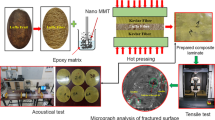Abstract
The mechanical behavior of a glass fiber/epoxy matrix composite used to repair steel pipes was evaluated after its exposure to oil under temperature at atmospheric pressure and at 17 bar. The effect of pressure was found to affect on a different way short-term and long-term properties of the composite. Under atmospheric pressure, more oil was absorbed by the composite than at 17 bar. This behavior was attributed to the effect of the hydrostatic pressure upon the polymeric matrix-free volume. The set of mechanical properties evaluated by tree-point bending test (flexural strength, elastic modulus, toughness, and deformation at maximum load) was also more affected when aging was conducted under atmospheric pressure. However, the steady state creep rate of the composite aged under 17 bar was higher than that of the material aged at atmospheric pressure, reducing the expected service life of the repair joint when both temperature and pressure are applied together.





Similar content being viewed by others
References
Hsu TM, Skogsberg J, Karayaka M (2001) Composites utilization on a spar platform—potential economic impact and technical gaps. In: Wang SS, Willians JG, Lo KH (eds) Composite materials for offshore operations, vol 3. University of Houston, CEAC Publishing, Houston, pp 19–43
Hota G, Liang R (2011) Advanced fiber reinforced polymer composites for sustainable civil infrastructures. In: International symposium on innovation & sustainability of structures in civil engineering, Xiamen University, China, 28–30 Oct
Shamsuddoha M, Mainul Islam M, Aravinthan T, Manalo A, Lau K-T (2013) Effectiveness of using fibre-reinforced polymer composites for underwater steel pipeline repairs. Comp Struct 100:40–54
Faraz MI, Besseling NAM, Korobko AV, Picken SJ (2015) Characterization and modeling of creep behavior of a thermoset nanocomposite. Polym Comp 36:322–329
Abdel-Magid B, Lopez-Anido R, Smith G, Trofka S (2003) Flexure creep properties of E-glass reinforced polymers. Comp Struct 62:247–253
Guedes RM (2009) Relationship between lifetime under creep and constant stress rate for polymer-matrix composites. Comp Sci Technol 69:1200–1205
Sullivan JL (1990) Creep and physical aging of composites. Comp Sci Technol 39:207–232
Papanicolaou GC, Xepapadaki AG, Zarouchas D (2009) Effect of water uptake on creep behaviour of glass–epoxy composites. Plast Rubber Comp 38:72–79
Law ACK (2007) Creep deformation and thermal aging of random glass-mat polypropylene composite. Master thesis, University of Waterloo, Ontario, Canada
de Souza LR, Marques AT, d’Almeida JRM (2017) Effects of aging on water and lubricating oil on the creep behavior of a GFRP matrix composite. Comp Struct 168:285–291
Hoppel CRP, Bogetti TA, Gillespie JW Jr. (1995) Effects of hydrostatic pressure on the mechanical behavior of composite materials. ARL-TR-727 Report, U.S. Army Research Laboratory, Aberdeen Proving Ground, MD, USA
Sigley RH, Wronski AS, Parry TV (1992) Tensile failure of pultruded glass–polyester composites under superimposed hydrostatic pressure. Comp Sci Technol 41:395–409
Tucker WC, Brown R (1989) Moisture absorption of graphite/polymer composites under 2000 feet of seawater. J Comp Mater 23:787–797
Avena A, Bunsell AR (1988) Effect of hydrostatic pressure on the water absorption of glass fibre-reinforced epoxy resin. Composites 19:355–357
Harper BD, Staab GH, Chen RS (1987) A note on the effects of voids upon the hygral and mechanical properties of AS4/3502 graphite/epoxy. J Comp Mater 21:280–289
Humeau C, Davies P, Jacquemin F (2016) Moisture diffusion under hydrostatic pressure in composites. Mater Des 96:90–98
Grogan DM, Flanagan M, Walls M, Leen SB, Doyle A, Harrison NH, Mamalis D, Goggins J (2018) Influence of microstructural defects and hydrostatic pressure on water absorption in composite materials for tidal energy. J Comp Mater. https://doi.org/10.1177/0021998318755428
Cheng J, Li J, Zhang JY (2009) Curing behavior and thermal properties of trifunctional epoxy resin cured by 4,4′-diaminodiphenyl sulfone. eXPRESS Polym Lett 3:501–509
Ma S, Liu W, Zhao Y, Yan Z, Gao N (2012) Curing behavior and thermal properties of autocatalytic cycloaliphatic epoxy. J Macromol Sci Part A 49:81–84
Alizadeh F, Sutherland LS, Guedes Soares C (2016) Effect of vacuum bag pressure on the flexural properties of GFRP composite laminates. In: Guedes Soares C, Santos TA (eds) Maritime technology and engineering 3, vol 1. CRC Press, Boca Raton, pp 429–434
Stern S, Dierdorf D (2005) Thermogravimetric analysis (TGA) of various epoxy composite formulations. Air Force Research Laboratory, Report 2005-4585, Tyndall AFB, FL
May CA (1987) Epoxy resins. In: Reinhart TJ (ed) Engineered materials handbook, vol 1. Composites. ASM International, Materials Park, pp 66–77
Valliappan M, Roux JA, Vaughan JG, Arafat ES (1996) Die and post-die temperature and cure in graphite/epoxy composites. Comp Part B 27:1–9
Carbas RJC, da Silva LFM, Marques EAS, Lopes AM (2013) Effect of post-cure on the glass transition temperature and mechanical properties of epoxy adhesives. J Adhes Sci Technol 27:2542–2557
Odegard GM, Bandyopadhyay A (2011) Physical aging of epoxy polymers and their composites. J Polym Sci Part B Polym Phys 49:1695–1716
Klopffer MH, Flaconnèche B (2001) Transport properties of gases in polymers: bibliographic review. Oil Gas Sci Technol 56(3):223–244
Shaito A, Fairbrother D, Sterling J, D’Souza NA (2010) Ethylene maleated amorphous propylene compatibilized polyethylene nanocomposites: stress and temperature effects on nonlinear creep. Polym Eng Sci 50:1633–1645
Eaton MJ, Pullin R, Holford KM (2012) Acoustic emission source location in composite materials using Delta T Mapping. Comp Part A 43:856–863
Chacón YG, Paciornik S, d’Almeida JRM (2010) Microstructural evaluation and flexural mechanical behavior of pultruded glass fiber composites. Mater Sci Eng A 528:172–179
Acknowledgements
The authors acknowledge the financial support from the Brazilian Agency Conselho Nacional de Desenvolvimento e Pesquisa (CNPq).
Author information
Authors and Affiliations
Corresponding author
Additional information
Technical Editor: Celso Kazuyuki Morooka.
Rights and permissions
About this article
Cite this article
Monteiro, J.R.L., d’Almeida, J.R.M. Evaluation of the mechanical performance of the creep behavior of a fiberglass repair after aging in oil. J Braz. Soc. Mech. Sci. Eng. 40, 346 (2018). https://doi.org/10.1007/s40430-018-1259-5
Received:
Accepted:
Published:
DOI: https://doi.org/10.1007/s40430-018-1259-5




